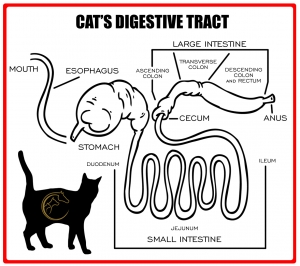ECS Series: GI Tract & Immune Support
Trust is no small thing and it’s sometimes hard to know who to trust when it comes to your pets’ health care. Your dog is a member of your family, and your cat allows you to be a member of hers. As family members, our cats and dogs hold special places in our lives, so we want to be extra careful when choosing supplement companies. We are humbled to have your trust that Canna Companion products are grounded in science and made with love, providing the best hemp pet supplement for your family member.
Today we’re continuing our discussion on how the endocannabinoid system (ECS) helps the body remain balanced, specifically within the gastrointestinal (GI) tract and immune system. Did you know 70% of the immune system is found in the GI tract, and that the ECS is integral to the normal development of GI tract motility? In addition, the balance the ECS always strives for has significant homeostatic effects on the immune system. Supporting the normal functions of that system with hemp supplements, a healthy diet and regular exercise, ensures your pet remains balanced and happy.
The Immune System
The immune system, like the endocannabinoid system, is quite complex in action, yet simplistic in function. And like the ECS, the immune system functions relatively the same between species. Immune systems aim to protect the body from all things and do this by incorporating three key types of immunity: physical barriers (skin, mucous membranes), innate immunity (certain white blood cells and their responses which are present at birth) and adaptive immunity (responses based on exposure to threats, whether perceived or real). They enlist the help of chemical messengers (interleukins), entire cell lines (immunoglobulins, white blood cells), and organs (spleen, thymus, GI tract) in order to protect the body from harm. When harm does occur, these same helpers go into overdrive, helping the body return to a healthful homeostasis.
Adaptive immunity is perhaps the most familiar aspect of the immune system as it deals with microbial exposure, which triggers a cascade of cellular events starting with chemical messenger release and culminating in memory cell formation. Interleukins alert the body that an invader is present, while memory cells help the body mount an appropriate immune response should exposure occur in the future. It is during this process that antibodies are made, either via vaccination or actual exposure to microbes.
When balanced, this system may produce mild fevers and malaise as the body defends itself with adaptive immune responses, a very active process. If unbalanced, responses from initial or subsequent exposure can be inappropriate relative to the inciting factor. Allergic responses are an example of an unbalanced state, whereas mild fevers in kittens during their first exposure to common upper respiratory tract viruses indicate a balanced healthy immune response.
Innate immunity is essentially the inflammatory responses which help the body repair minor damage like bruising and lacerations, and their associated mild/superficial infections. Inflammation ensures delivery of white blood cells specializing in eating or otherwise destroying invaders and dead tissues. When your puppy barrels around the corner, playing chase with your human child, and catches his hip on the hallway corner, innate immunity immediately goes into effect. Interleukins again alert the body something is awry and the acute inflammatory cascade is triggered, bringing white blood cells which can repair the damaged tissue. The process is clearly visible in the form of a large bruise which fades over time. This too can become unbalanced though there are often a variety of causative factors which result in runaway inflammation (and are beyond the scope of this discussion).
Physical barriers are arguably the most important aspect of the immune system as they are the first line of defense. They are also the largest aspect of the immune system covering the body inside and out. Externally our pets rely on fur and skin, and even ocular tissues like the cornea, to physically protect deeper, more delicate tissues. Internally mucous membranes cover all non-furred areas, offering both a physical layer and an antibody rich liquid covering (mucus) which sheds potential invaders while bathing them in defensive cells.
In addition, commensal microbes make up a large portion of physical barriers, greatly contributing to the overall immune system’s appropriate response. They challenge the immune system on a regular basis, keeping it on it’s toes and ready to respond to more aggressive threats. Lastly, commensal microbes compete for valuable housing space, preventing harmful organisms (pathogens) from colonizing and causing disease.
Gastrointestinal Tract
It is both the liquid covering (mucosa) and commensal organisms (microbiota making up the microbiome) that greatly contribute to the immune system. But the gastrointestinal tract has a few more tricks up its sleeve which makes it the workhorse of the immune system: digestive enzymes which can be lethal to pathogens, extremely large surface area (more than the skin) and highly muscular “tubes” designed to expel toxins quickly (when needed). The GI tract begins in the oral cavity, extends into the stomach and small & large intestines, then into the rectum and finally anal tissues. Along the way, the neurological system is deeply involved, as are the spleen (reservoir for many immune cells) and the gallbladder and pancreas (digestive enzyme excreters).
Tying It All Together
Now that we understand a bit about how the immune system works, and how the GI tract is included in that system, let’s bring things back around to the ECS. A healthy, normally functioning endocannabinoid system is necessary for the normal functions of the GI tract. It accomplishes this task primarily via modulation of nerves at various stages and junctions throughout the body, including mucosal cells and blood vessels. That modulation occurs via cytokines, chemical messengers like interleukins.
We’ve learned that interleukins are involved in all aspects of the immune system, serving as an alert system that something is unbalanced, or signaling the all clear – balance is restored. The ECS is also listening to those same interleukins and responds via down or upregulation of cannabis receptors in those areas, whatever the body needs to maintain balance. It does this via alterations in intracellular and extracellular concentrations of compounds like CBD & THC at receptor sites. When in balance, receptors are better able to respond to interleukins and thus to the needs of the gastrointestinal tract and immune system. Supporting the endocannabinoid system with similarly balanced supplements, provides the body all it needs for healthful homeostasis. That support translates into more quality time with your favorite lap warmer or running enthusiast.
Thank you again for placing your trust in Canna Companion. We continue our ECS Series with the neurological system, the foundation for all ECS actions.










